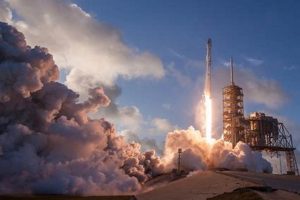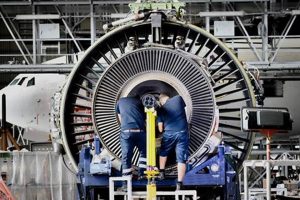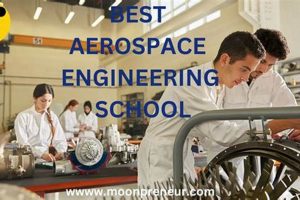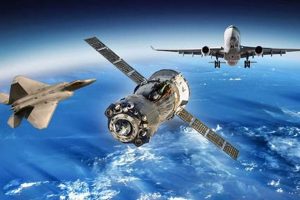The pursuit of a career in aerospace engineering necessitates a robust foundation in science, technology, engineering, and mathematics (STEM). Aspiring professionals typically require a bachelor’s degree in aerospace engineering or a closely related field such as mechanical engineering. This undergraduate education provides core competencies in areas like aerodynamics, propulsion, structural analysis, and control systems. Furthermore, specialized coursework focusing on aircraft or spacecraft design is common.
The attainment of a suitable academic background offers significant advantages. It equips individuals with the theoretical knowledge and practical skills essential for designing, developing, testing, and maintaining aircraft, spacecraft, and related systems. Historically, advancements in aerospace technology have been driven by engineers with rigorous academic training and a commitment to innovation, contributing to improvements in air travel, space exploration, and national security.
The educational path represents only one aspect of preparation. Beyond the degree itself, practical experience gained through internships, research opportunities, and participation in engineering design projects significantly enhances a candidate’s prospects. Additionally, strong analytical and problem-solving abilities, coupled with proficiency in computer-aided design (CAD) software and other relevant technologies, are essential for success in this demanding field. Professional licensure, though not always mandatory, can also demonstrate competence and commitment to ethical practice.
The following tips offer guidance to individuals seeking a career as an aerospace engineer. These recommendations emphasize strategic academic choices and professional development activities.
Tip 1: Cultivate a Strong STEM Foundation: Excel in mathematics and science courses throughout primary and secondary education. A solid understanding of calculus, physics, and chemistry is crucial for future success in aerospace engineering coursework.
Tip 2: Pursue a Relevant Undergraduate Degree: Obtain a bachelor’s degree in aerospace engineering or a closely related field such as mechanical engineering, electrical engineering, or physics. Ensure the program is accredited by ABET (Accreditation Board for Engineering and Technology) to meet industry standards.
Tip 3: Gain Practical Experience: Seek internships or co-op opportunities with aerospace companies, government agencies, or research institutions. Hands-on experience is invaluable for applying theoretical knowledge and developing practical skills.
Tip 4: Develop Proficiency in Relevant Software: Master computer-aided design (CAD) software, computational fluid dynamics (CFD) tools, and other engineering software commonly used in the aerospace industry. This proficiency enhances design and analysis capabilities.
Tip 5: Engage in Research: Participate in undergraduate research projects related to aerospace engineering topics. This experience fosters critical thinking, problem-solving skills, and the ability to contribute to advancements in the field.
Tip 6: Consider a Graduate Degree: Explore the possibility of pursuing a master’s or doctoral degree in aerospace engineering to specialize in a specific area of interest and enhance career prospects. Advanced degrees can open doors to research and development roles.
Tip 7: Seek Professional Licensure: After gaining sufficient experience, pursue professional engineering (PE) licensure. Although not always mandatory, licensure demonstrates competence and commitment to ethical practice.
These tips offer a structured approach to acquiring the necessary skills and experience for a successful aerospace engineering career. Diligent adherence to these guidelines improves career prospects and contributes to professional growth.
The information provided serves as a roadmap for those aspiring to join the aerospace engineering profession. Further research and networking within the industry are encouraged to stay abreast of evolving trends and opportunities.
1. Academic Degree
The attainment of an academic degree serves as the cornerstone for any aspiring aerospace engineer. A rigorous curriculum provides the theoretical foundation and practical skills necessary to navigate the complexities of designing, developing, and testing aerospace vehicles and systems. It is a fundamental component when considering the question of what qualifications are needed.
- Bachelor’s Degree in Aerospace Engineering or Related Field
A Bachelor’s degree in Aerospace Engineering, or a closely related field such as Mechanical Engineering with an aerospace concentration, establishes a fundamental understanding of aerodynamics, propulsion, structures, control systems, and materials science. This degree is often the minimum requirement for entry-level positions and provides a broad overview of the aerospace industry. Examples include designing aircraft wings, analyzing stress on spacecraft components, and simulating flight dynamics. The implications extend to enabling graduates to contribute to diverse aspects of aerospace projects, from design to testing and analysis.
- ABET Accreditation
Ensuring that the chosen academic program is accredited by ABET (Accreditation Board for Engineering and Technology) is crucial. ABET accreditation signifies that the program meets established quality standards for engineering education. Employers often prioritize graduates from ABET-accredited programs, as it provides assurance of a standardized curriculum and competent instruction. This accreditation assures adherence to industry best practices and prepares graduates for professional licensure. The consequences of selecting a non-ABET accredited program can include limitations on future employment opportunities and professional advancement.
- Advanced Degrees (Master’s and Doctoral)
For individuals seeking specialization or research-intensive roles, advanced degrees such as a Master’s or Doctoral degree in Aerospace Engineering are often necessary. These programs allow for in-depth study in areas like astrodynamics, computational fluid dynamics, or composite materials. A Master’s degree can lead to more advanced engineering roles, while a Doctoral degree is typically required for academic or research positions. The implications are clear: advanced degrees often translate to increased earning potential and opportunities to contribute to cutting-edge research.
- Specialized Coursework
The academic degree should also incorporate specialized coursework relevant to the desired career path within aerospace engineering. This could include courses in spacecraft design, propulsion systems, avionics, or aerodynamics. These specialized courses enable candidates to develop expertise in a specific area, improving their appeal to employers seeking specialized skill sets. For example, focusing on spacecraft design involves learning about orbital mechanics, satellite subsystems, and mission planning. This targeted knowledge prepares individuals for specific roles, such as spacecraft systems engineers or mission analysts.
In summary, an academic degree, specifically one that is ABET-accredited and includes specialized coursework, is an indispensable component when addressing the question of what qualifications are needed to become an aerospace engineer. It provides the foundational knowledge, technical skills, and professional recognition required to enter and succeed in this challenging and rewarding field.
2. Technical Proficiency
Technical proficiency constitutes a critical element of the qualifications necessary for a career in aerospace engineering. The ability to apply theoretical knowledge to practical problems and effectively utilize relevant software and tools is paramount. Without a demonstrably high level of technical skill, an individual’s contribution to the field will be significantly limited, regardless of their academic credentials. Consider the design of an aircraft wing: theoretical calculations of lift and drag are insufficient without the practical ability to model the wing’s performance using computational fluid dynamics (CFD) software and interpret the results to optimize its aerodynamic efficiency. This proficiency directly impacts the safety, performance, and cost-effectiveness of the final design.
The acquisition of technical skills often involves hands-on experience and continuous learning. Internships, co-operative education programs, and personal projects provide opportunities to develop competence in areas such as CAD software (e.g., CATIA, SolidWorks), programming languages (e.g., MATLAB, Python), and simulation tools (e.g., ANSYS). For instance, an aerospace engineer might use CAD software to create detailed 3D models of aircraft components, then use finite element analysis (FEA) software to assess their structural integrity under various loading conditions. This process demands a thorough understanding of the underlying principles of structural mechanics and the ability to interpret simulation results to identify potential design flaws. Moreover, effective communication of technical findings, through reports and presentations, is essential for collaboration and decision-making within engineering teams.
In conclusion, technical proficiency is not merely a supplementary attribute but a foundational requirement within the broader scope of qualifications for aerospace engineers. Its absence significantly diminishes an engineer’s ability to contribute meaningfully to the design, analysis, and implementation of aerospace systems. The continuous development of technical skills, combined with a strong theoretical foundation, is essential for ensuring the safety, efficiency, and innovation that define the aerospace industry. The demand for increasingly complex and sophisticated aerospace systems necessitates engineers who possess both theoretical understanding and practical expertise in applying advanced technologies and tools.
3. Analytical Skills
The aerospace engineering discipline necessitates a highly developed capacity for analytical reasoning. Analytical skills are not merely desirable, but rather a critical component when considering the question of what qualifications are needed. This ability to dissect complex systems, identify critical variables, and formulate solutions grounded in data is essential for success in this field. The relationship between analytical skills and aerospace engineering is causal: a deficiency in analytical ability directly impedes an engineer’s capacity to perform core tasks such as stress analysis of aircraft structures, optimization of aerodynamic performance, or troubleshooting malfunctions in complex aerospace systems. Without these skills, the likelihood of errors in design, leading to potential failures and safety hazards, increases substantially.
Consider, for example, the design of a spacecraft’s thermal control system. Engineers must analyze vast amounts of data regarding solar radiation, internal heat generation, and the thermal properties of various materials. This analysis requires proficiency in mathematical modeling, statistical analysis, and the interpretation of simulation results. Incorrect or incomplete analysis could lead to overheating or excessive cooling of critical components, potentially resulting in mission failure. The practical application of analytical skills also extends to risk assessment, failure analysis, and the development of mitigation strategies. Aerospace engineers are frequently tasked with identifying potential hazards and developing contingency plans to minimize their impact. This requires a systematic approach to problem-solving, based on a thorough understanding of the underlying physical principles and the potential failure modes of complex systems.
In conclusion, the analytical skills required for aerospace engineering represent a cornerstone of professional competence. These skills are inseparable from the ability to contribute meaningfully to the design, development, and maintenance of aerospace systems. The complex nature of aerospace engineering demands a commitment to rigorous analysis and a continuous refinement of analytical capabilities. While theoretical knowledge and practical experience are undoubtedly important, it is the capacity for critical thinking and data-driven decision-making that ultimately distinguishes a proficient aerospace engineer. The challenges associated with this discipline underscore the significance of analytical prowess in ensuring the safety, reliability, and efficiency of aerospace endeavors.
4. Problem-Solving Acumen
Problem-solving acumen is an indispensable qualification for aerospace engineers. The field inherently involves navigating complex challenges related to design, functionality, and safety. Deficiencies in this area directly compromise an engineer’s capacity to effectively address issues arising during the design, development, and operation of aerospace systems. A causal relationship exists: insufficient problem-solving skills lead to increased risks of design flaws, operational inefficiencies, and potential safety hazards. For instance, an unexpected vibration issue during the testing phase of a new aircraft demands a systematic approach to identify the root cause, evaluate potential solutions, and implement the most effective remedy. Without adept problem-solving abilities, identifying the source of the vibration and mitigating it could prove insurmountable, potentially delaying the project and increasing costs.
The practical application of problem-solving acumen extends beyond identifying and resolving technical issues. It encompasses the ability to anticipate potential problems and proactively develop strategies to mitigate them. Consider the design of a spacecraft’s communication system. Engineers must anticipate potential interference from various sources, develop robust error-correction algorithms, and implement redundant systems to ensure reliable communication under adverse conditions. This proactive approach to problem-solving minimizes the risk of communication failures, which could jeopardize the entire mission. Furthermore, aerospace engineers are often required to work in multidisciplinary teams, collaborating with experts from diverse fields. Effective problem-solving in this context necessitates the ability to communicate technical concepts clearly, synthesize diverse perspectives, and negotiate solutions that address the needs of all stakeholders. This requires not only technical expertise but also strong interpersonal and communication skills.
In summary, problem-solving acumen represents a fundamental qualification for aerospace engineers. Its presence is a determining factor in an engineer’s ability to effectively design, develop, and operate safe, efficient, and reliable aerospace systems. The ability to systematically analyze problems, develop creative solutions, and implement effective remedies is indispensable for navigating the challenges inherent in this complex field. The absence of these skills poses significant risks, underscoring the critical importance of cultivating and honing problem-solving abilities throughout an aerospace engineer’s education and professional development.
5. Practical Experience
Practical experience forms a crucial bridge between theoretical knowledge and real-world application in the field of aerospace engineering. This hands-on component is inextricably linked to the qualifications sought in prospective aerospace engineers, representing more than just a supplementary asset. The absence of practical experience diminishes an engineers ability to effectively contribute to the design, development, and testing of aerospace systems. The importance of this facet cannot be overstated; theoretical understanding alone is insufficient without practical application. For example, while an engineer may possess a comprehensive understanding of aerodynamics, the ability to apply this knowledge in a wind tunnel testing environment, analyzing real-world data and adjusting designs accordingly, is a separate and indispensable skill. This practical engagement informs the design process, leading to safer, more efficient, and more reliable aerospace systems.
The acquisition of practical experience is facilitated through various avenues, including internships, co-operative education programs, research projects, and personal engineering endeavors. Internships within aerospace companies or research institutions provide invaluable exposure to industry practices and real-world engineering challenges. Consider an internship where an engineer is tasked with designing and testing a component for a satellite propulsion system. This experience necessitates the application of theoretical knowledge, proficiency with relevant software tools, and the ability to collaborate with experienced engineers. The challenges encountered during this process, such as unexpected material behaviors or manufacturing constraints, provide critical learning opportunities that cannot be replicated in a classroom setting. Similarly, participation in research projects focused on areas such as composite materials or advanced propulsion systems allows engineers to contribute to cutting-edge research while gaining practical experience in experimental design, data analysis, and report writing.
In summation, practical experience constitutes an integral and non-negotiable element when assessing what qualifications are needed to become a successful aerospace engineer. It serves as a vital catalyst for translating theoretical knowledge into practical competence, enabling engineers to effectively address the complex challenges inherent in the aerospace field. The incorporation of practical experience into an engineer’s education and professional development not only enhances their skills but also fosters a deeper understanding of the intricacies and realities of the aerospace industry. Therefore, the pursuit of opportunities to gain hands-on experience is paramount for any aspiring aerospace engineer seeking to make a meaningful contribution to the field.
Frequently Asked Questions
The following addresses common inquiries regarding the necessary attributes and preparation for a career in aerospace engineering. These answers offer insight into the academic, technical, and professional benchmarks.
Question 1: Is a Master’s degree essential for a career in aerospace engineering?
While a Bachelor’s degree in Aerospace Engineering or a related field often suffices for entry-level positions, a Master’s degree can provide a competitive advantage. It allows for specialization in a specific area, potentially leading to advanced roles and increased earning potential. The necessity of a Master’s degree is contingent upon career aspirations and the specific requirements of the desired position.
Question 2: How important is practical experience, such as internships?
Practical experience is highly valued. Internships, co-operative education programs, and research projects provide invaluable opportunities to apply theoretical knowledge to real-world problems, develop essential skills, and gain industry exposure. Such experiences often differentiate candidates in a competitive job market.
Question 3: What specific software skills are most beneficial?
Proficiency in Computer-Aided Design (CAD) software (e.g., CATIA, SolidWorks), Computational Fluid Dynamics (CFD) tools (e.g., ANSYS Fluent), and programming languages (e.g., MATLAB, Python) are highly advantageous. These tools are widely used in aerospace engineering for design, analysis, and simulation purposes.
Question 4: Does professional licensure enhance career prospects?
Professional Engineering (PE) licensure, while not always mandatory, demonstrates competence, commitment to ethical practice, and a recognized level of expertise. Licensure can enhance credibility and expand career opportunities, particularly in roles involving public safety or regulatory compliance.
Question 5: What role do analytical skills play in this profession?
Analytical skills are paramount. Aerospace engineers must be able to dissect complex systems, interpret data, and formulate solutions grounded in evidence-based reasoning. A strong foundation in mathematics, physics, and statistics is essential for developing these skills.
Question 6: Are strong communication skills necessary for aerospace engineers?
Effective communication is crucial. Aerospace engineers must be able to clearly communicate technical concepts to colleagues, clients, and stakeholders, both verbally and in writing. Collaboration and teamwork are integral aspects of the profession.
The inquiries highlight the multidimensional nature of the qualifications needed. A blend of academic rigor, practical application, and professional attributes is essential for success.
The next section delves into the career paths available within aerospace engineering.
Conclusion
The preceding discussion elucidates the multifaceted requirements for aspiring aerospace engineers. Mastering core subjects, acquiring technical proficiency, developing analytical acumen, refining problem-solving skills, and gaining practical experience are indispensable for success. Furthermore, professional licensure and effective communication skills significantly enhance career prospects within this demanding and rapidly evolving field.
The path to becoming a qualified aerospace engineer demands dedication and continuous learning. As technological advancements reshape the industry, aspiring professionals must remain committed to expanding their knowledge and honing their skills to contribute meaningfully to the future of aerospace innovation. Rigorous academic preparation, coupled with hands-on experience and a dedication to lifelong learning, will empower future generations of aerospace engineers to navigate the challenges and opportunities that lie ahead.







